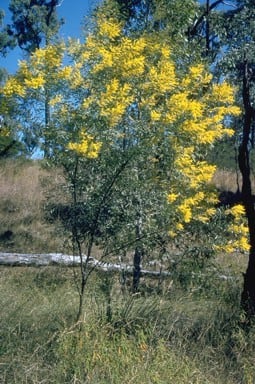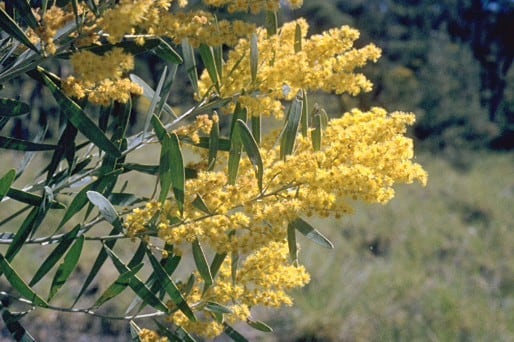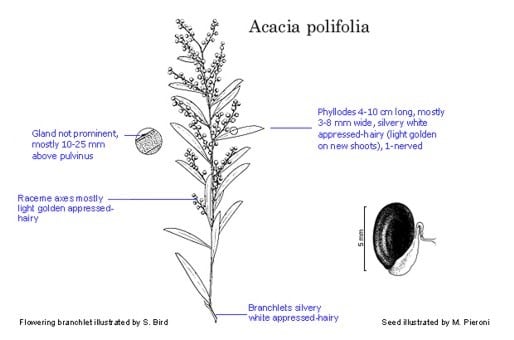Acacia polifolia Pedley
WATTLE
Acacias of Australia
Family
Fabaceae
Distribution
Confined to the Great Divide from the Jericho–Tambo area E to Mt Morgan and near Biloela, Qld.
Description
Shrub or tree to 5 m high. Branchlets moderately to densely appressed-puberulous with straight silvery-white hairs. New shoots light golden appressed-puberulous. Phyllodes narrowly elliptic, oblanceolate or narrowly oblong to ±linear, 4–10 cm long, 3–8 (–12) mm wide, acute or obtuse-mucronate, thin, moderately to densely appressed-puberulous with silvery white hairs, 1-nerved per face; lateral nerves obscure; gland not prominent, 1–2.5 (–3) cm above pulvinus. Inflorescences racemose; raceme axes 2–6 cm long, appressed-puberulous with predominantly light golden hairs; heads globular, 15–20-flowered, bright lemon yellow to golden; peduncles 2–5 mm long, appressed-puberulous with silvery white to light golden hairs. Flowers 5-merous; sepals c. 2/3-united; ovary glabrous. Pods to 8 cm long, 8–11 mm wide, firmly chartaceous to thinly coriaceous, pruinose, glabrous, dehiscing unilaterally. Seeds longitudinal, oblong-elliptic to slightly ovate, 4–5 mm long, slightly shiny, black; aril clavate.
Habitat
Normally grows in shallow sand on sandstone, in Eucalyptus or Angophora forest or woodland.
Specimens
Qld: Jericho, June 1913, J.L.Boorman (NSW, PERTH); Blackdown Tableland, c. 32 km SE of Blackwater, R.J.Henderson, L.Durrington & P.Sharpe 989 (BRI); Callide Open Cut, c. 25 km NE of Biloela, L.A.S.Johnson 7125 & B.G.Briggs (BRI, NSW); Upper Maranoa R., c. 100 km NW of Injune, I.R.Telford 5842 (BRI).
Notes
The concept of A. polifolia is here expanded to include specimens from Blackdown Tableland, Mt Morgan and Callide Valley which L.Pedley, Austrobaileya 1: 284 (1980), included within A. pubicosta. The Blackdown Tableland and Mt Morgan specimens have acute, especially narrow, elongate phyllodes (5–10 cm long, 3–5 mm wide, l:w = 12–26) and thus may superficially resemble A. pubicosta; the Callide Valley flowering specimen (phyllodes 7–8 cm long, 7 mm wide, l:w = 10–11) is close to Pedley’s original concept of A. polifolia. As currently defined, A. pubicosta differs by having silvery white, appressed pubescence on new shoots, raceme axes and commonly peduncles, phyllodes ±glabrous or more commonly appressed-puberulous on midribs, a gland 5–10 mm above pulvinus, white or cream-coloured flower-heads and glabrous, blackish pods.
Acacia polifolia is readily distinguished from A. barringtonensis and its allies from N.S.W. by the golden coloured indumentum as noted above. It is sometimes sympatric with A. decora which commonly has a similar indumentum on its raceme axes and peduncles; in the field these two species may be confused with A. deuteroneura.
FOA Reference
Data derived from Flora of Australia Volumes 11A (2001), 11B (2001) and 12 (1998), products of ABRS, ©Commonwealth of Australia
Author
B.R.Maslin
Minor edits by B.R.Maslin & J.Rogers
This identification key and fact sheets are available as a mobile application:
URL: https://apps.lucidcentral.org/wattle/
© Copyright 2018. All rights reserved.









